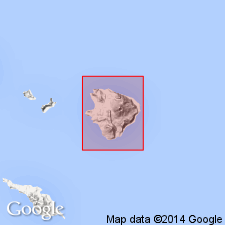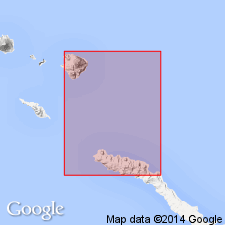
- Usage in publication:
-
- Williwaw Cove formation*
- Modifications:
-
- Named
- Dominant lithology:
-
- Andesite
- Basalt
- Pyroclastics
- AAPG geologic province:
-
- Aleutian Islands province
- Alaska Southwestern region
Summary:
Named from exposures in sea cliffs on west side of Williwaw Cove, Little Sitkin Island, Rat Islands group, Aleutian Islands, AK. Forms base upon which all later volcanic deposits accumulated. Shown on geologic map of Little Sitkin Island. Consists of thick sequence of andesite and bandaite flows with minor amounts of basalt and dacite flows and major amounts of pyroclastic material. Vertical sea cliff exposures as much as 500 ft high appear to be single flow. Andesite adjacent to West Cove member (new) of Little Sitkin dacite (new) has been highly altered by fumarolic activity. Has very irregular contacts with younger rocks; locally has relief of several 1000 ft. Age is probably late Tertiary or early Quaternary judging from flow's advanced dissection.
Source: GNU records (USGS DDS-6; Menlo GNULEX).

- Usage in publication:
-
- Williwaw Cove Formation*
- Modifications:
-
- Age modified
- Geochronologic dating
- AAPG geologic province:
-
- Aleutian Islands province
- Alaska Southwestern region
Summary:
K-Ar age on whole rock from Williwaw Cove Formation yielded 1.7 +/-0.6 Ma (W.J. Carr and others, 1973, written commun.) Age thus is early Pleistocene.
Source: GNU records (USGS DDS-6; Menlo GNULEX).
For more information, please contact Nancy Stamm, Geologic Names Committee Secretary.
Asterisk (*) indicates published by U.S. Geological Survey authors.
"No current usage" (†) implies that a name has been abandoned or has fallen into disuse. Former usage and, if known, replacement name given in parentheses ( ).
Slash (/) indicates name conflicts with nomenclatural guidelines (CSN, 1933; ACSN, 1961, 1970; NACSN, 1983, 2005, 2021). May be explained within brackets ([ ]).

